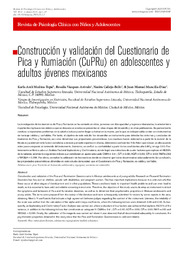Por favor, use este identificador para citar o enlazar este ítem:
https://hdl.handle.net/11000/29293Registro completo de metadatos
| Campo DC | Valor | Lengua/Idioma |
|---|---|---|
| dc.contributor.author | Medina-Tepal, Karla Areli | - |
| dc.contributor.author | Vázquez-Arévalo, Rosalia | - |
| dc.contributor.author | Calleja-Bello, Nazira | - |
| dc.contributor.author | Mancilla-Díaz, Juan Manuel | - |
| dc.contributor.other | Departamentos de la UMH::Psicología de la Salud | es_ES |
| dc.date.accessioned | 2023-06-07T08:18:42Z | - |
| dc.date.available | 2023-06-07T08:18:42Z | - |
| dc.date.created | 2023-05 | - |
| dc.identifier.citation | Revista de Psicología Clínica con Niños y Adolescentes Vol. 10 nº. 2- mayo 2023 | es_ES |
| dc.identifier.issn | 2340-8340 | - |
| dc.identifier.uri | https://hdl.handle.net/11000/29293 | - |
| dc.description.abstract | La investigación de los trastornos de Pica y Rumiación se ha centrado en niños, personas con discapacidad y mujeres embarazadas, lo anterior tiene importantes implicaciones debido a que se desconoce si estos se presentan en otras etapas del desarrollo y en otras poblaciones. Su padecimiento conduce a importantes problemas en la salud e incluso pueden llegar a derivar en la muerte, por lo que es indispensable contar con instrumentos de tamizaje válidos y confiables. Por tanto, el objetivo de este estudio fue desarrollar un instrumento para detectar los síntomas y conductas de trastornos de Pica y Rumiación, así como determinar sus propiedades psicométricas. Los reactivos fueron elaborados a partir de la revisión de la literatura y posteriormente fueron sometidos a revisión por siete expertos en el área, obteniendo coeficientes V de Aiken que indican un alto acuerdo entre jueces respecto al contenido del instrumento. Asimismo, se verificó su confiabilidad a partir de los coeficientes alfa 0.85 y omega 0.93. Posteriomente se llevó a cabo un Análisis Factorial Exploratorio y Confirmatorio, donde logró una estructura de cuatro factores que explican el 48.35% de la varianza, además los siguientes índices que corroboran un ajuste adecuado CMIN = 2.41, GFI = 0.92; AGFI = 0.89; CFI = 0.93; RMR=.063 y RMSEA = 0.064. Por último, se realizó la calibración de los reactivos donde se observó que todos discriminaban adecuadamente. En conclusión, las propiedades psicométricas obtenidas en este estudio demuestran que el Cuestionario de Pica y Rumiación, es válido y confiable. | es_ES |
| dc.description.abstract | Construction and validation of the Pica and Rumination Questionnaire in Mexican adolescents and young adults. Research on Pica and Rumination Disorders has focused on children, people with disabilities, and pregnant women. This has important implications because it is unknown whether these occur at other stages of development and in other populations. These conditions leads to important health problems and can even lead to death, so it is essential to have valid and reliable screening instruments. Therefore, the objective of this study was to develop an instrument to detect the symptoms and behaviors of Pica and Rumination disorders, as well as to determine their psychometric properties in Mexican adolescents and young adults. The items were prepared from the review of the literature and were subsequently submitted for review by seven experts in the area, obtaining Aiken’s V coefficients that indicate a high agreement between judges regarding the content of the instrument. Likewise, the reliability of the scale was verified from the calculation of the alpha and omega coefficients, where the following indices were obtained: 0.85 and 0.93. Subsequently, an Exploratory and Confirmatory Factor Analysis was carried out, where a structure of four factors was achieved that explains 48.35% of the variance, in addition to the following indices that corroborate an adequate fit CMIN = 2.41, GFI = 0.92; AGFI = 0.89; CFI = 0.93; RMR =.063 and RMSEA = 0.064. Finally, the calibration of the reagents was carried out where it was observed that all discriminated adequately. In conclusion, the psychometric properties obtained in this study show that the Pica and Rumination Questionnaire is valid and reliable. | es_ES |
| dc.format | application/pdf | es_ES |
| dc.format.extent | 10 | es_ES |
| dc.language.iso | spa | es_ES |
| dc.publisher | Universidad Miguel Hernández de Elche | es_ES |
| dc.rights | info:eu-repo/semantics/openAccess | es_ES |
| dc.rights | Attribution-NonCommercial-NoDerivatives 4.0 Internacional | * |
| dc.rights.uri | http://creativecommons.org/licenses/by-nc-nd/4.0/ | * |
| dc.subject | Trastorno de Rumiación | es_ES |
| dc.subject | Adolescente | es_ES |
| dc.subject | regurgitar | es_ES |
| dc.subject | Pica | es_ES |
| dc.subject | sustancias no comestibles | es_ES |
| dc.subject.other | CDU::1 - Filosofía y psicología::159.9 - Psicología | es_ES |
| dc.title | Construcción y validación del Cuestionario de Pica y Rumiación (CuPRu) en adolescentes y adultos jóvenes mexicanos | es_ES |
| dc.type | info:eu-repo/semantics/article | es_ES |
| dc.identifier.doi | 10.21134/rpcna.2023.10.2.2 | - |
| dc.relation.publisherversion | https:/doi.org/10.21134/rpcna.2023.10.2.2 | es_ES |

Ver/Abrir:
2216.1_0.pdf
269,22 kB
Adobe PDF
Compartir:
 La licencia se describe como: Atribución-NonComercial-NoDerivada 4.0 Internacional.
La licencia se describe como: Atribución-NonComercial-NoDerivada 4.0 Internacional.
.png)